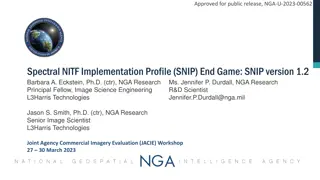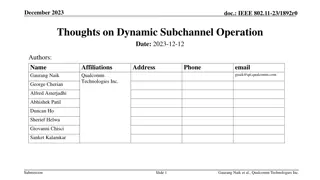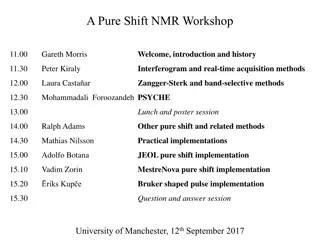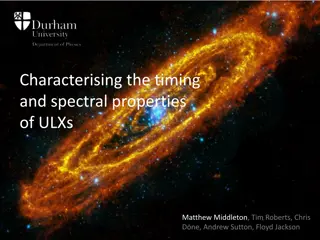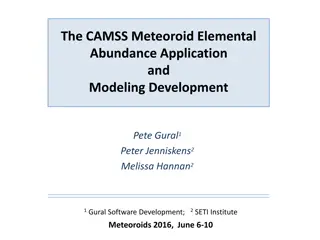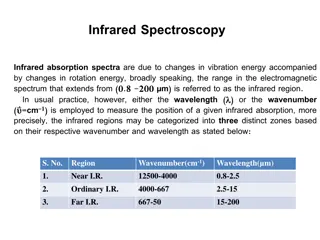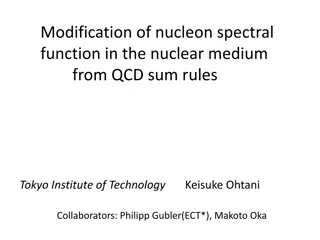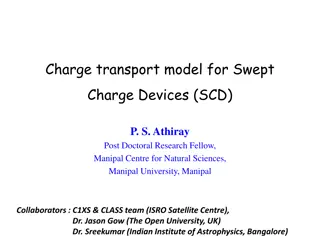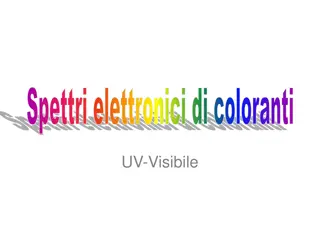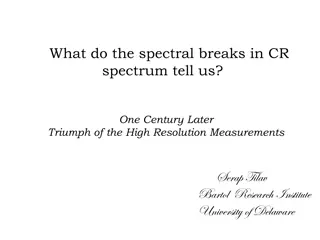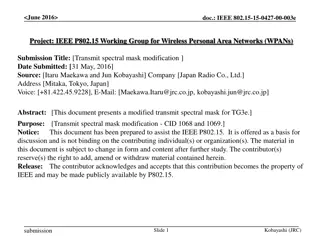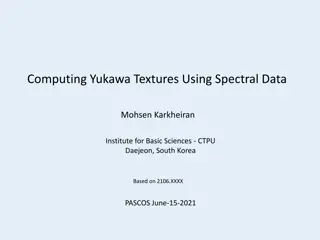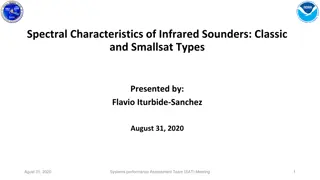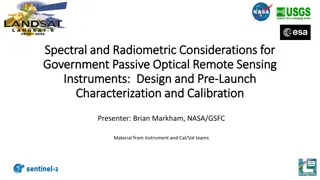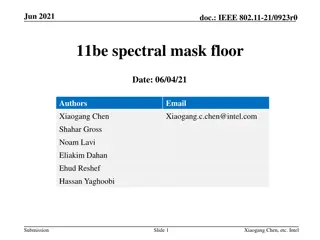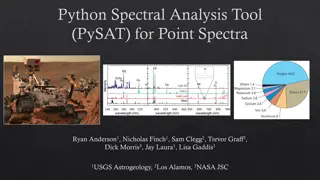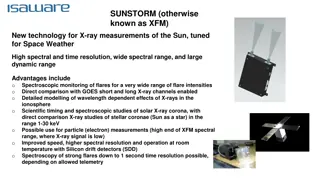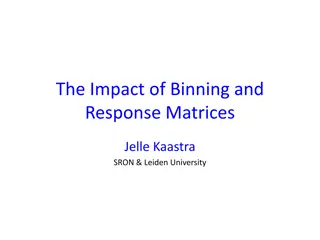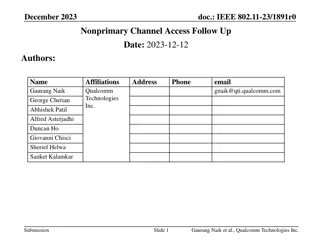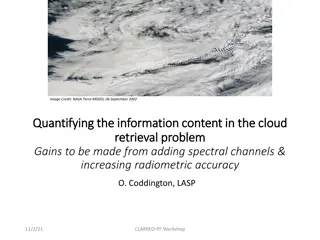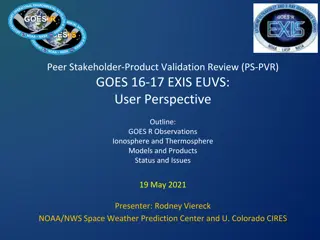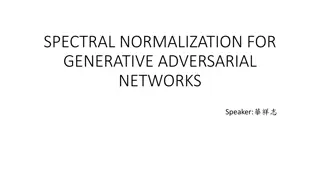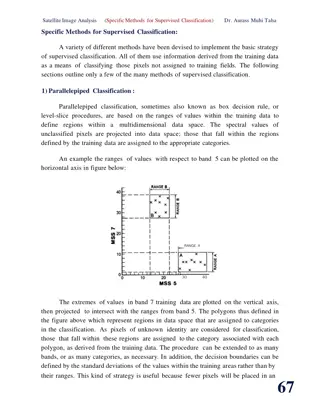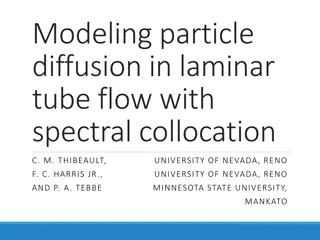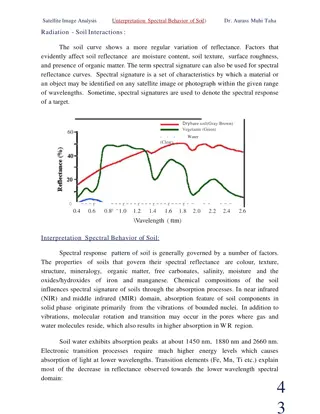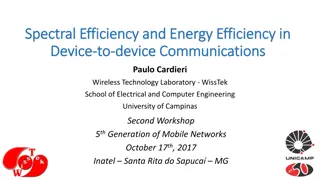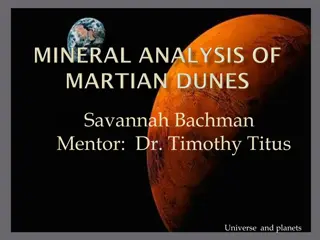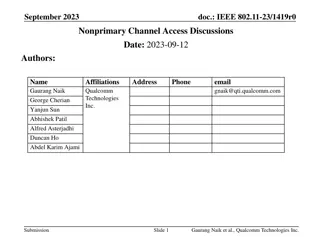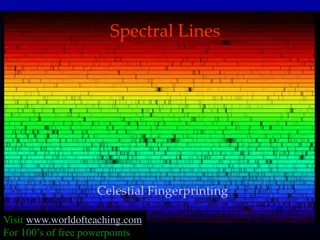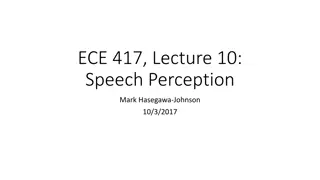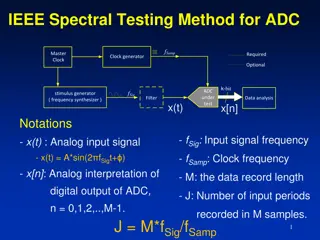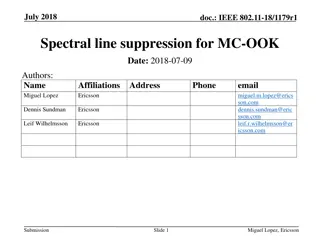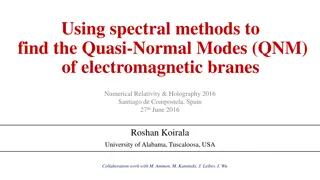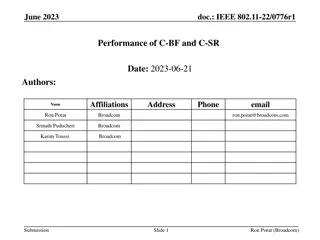Enhanced Spectral NITF Implementation Profile (SNIP) Version 1.2 Overview
This document outlines the Spectral NITF Implementation Profile (SNIP) version 1.2, its development, applications, and new elements. SNIP is a mandated standard for EO still imagery on DoD and IC systems, aiming to reduce integration costs and meet advanced exploitation needs for future HSI systems.
2 views • 14 slides
Dynamic Subchannel Operation in IEEE 802.11-23/1892r0: Enhancing Spectral Efficiency
The document discusses the implementation of Dynamic Subchannel Operation in IEEE 802.11 to address underutilization of bandwidth by narrowband devices. By allowing dynamic switching to secondary subchannels, the aim is to maximize spectral efficiency and enable communication with narrowband STAs on
0 views • 9 slides
Rate Optimization in Wideband RIS-assisted Wireless Systems
This research focuses on rate optimization in wideband RIS-assisted wireless systems, specifically investigating MIMO RIS-assisted systems in sub-6 GHz mmWave settings. Pathloss and blockage modeling, along with LOS vs. spectral efficiency and RIS-UE distance vs. spectral efficiency analyses, are ke
1 views • 4 slides
Evaluation of IEEE 802.11ax for IMT-2020 eMBB Dense Urban Test Environment
This document discusses the evaluation of IEEE 802.11ax technology in the context of the IMT-2020 Enhanced Mobile Broadband (eMBB) Dense Urban test environment. It analyzes the performance of 802.11ax in meeting the key PHY/MAC metrics required for eMBB Dense Urban scenarios, such as Peak Spectral E
2 views • 13 slides
Pure Shift NMR Workshop: Advancements and Insights
Explore the latest developments and insights in Pure Shift NMR spectroscopy through presentations on acquisition methods, implementations, and the quest for spectral purity. Discover the evolution of magnet development and the potential of high-temperature superconductivity in NMR technology. Delve
2 views • 27 slides
Ultraluminous X-ray Sources (ULXs) Properties
Explore the timing and spectral properties of Ultraluminous X-ray Sources (ULXs) through research conducted by Middleton, Gladstone, Roberts, Done, Uttley, and others. Learn about the spectral shapes, spectral deconvolutions, variability in X-ray spectra, timing tools, classification into low and hi
0 views • 23 slides
Quantum Query Complexity Measures for Symmetric Functions
Explore the relationships between query complexity measures, including quantum query complexity, adversary bounds, and spectral sensitivity, in the context of symmetric functions. Analysis includes sensitivity graphs, the quantum query model, and approximate counting methods. Results cover spectral
0 views • 19 slides
CAMSS Meteoroid Elemental Abundance Application and Modeling Development
Cameras for All-sky Meteor Surveillance Spectroscopy (CAMSS) aims to obtain meteoroid elemental abundances through relative ratios and absolute atom counts, sampling from comets and asteroids. The system uses grating cameras with high resolutions to automate spectral analysis processes. The CAMSS Co
0 views • 14 slides
Infrared Spectroscopy: An Overview of Vibration Energy and Spectral Regions
Infrared spectroscopy involves analyzing absorption spectra resulting from changes in vibration and rotation energy in molecules. The infrared region spans from 0.8 to 200 μm, with distinct zones categorized based on wavenumber and wavelength. Group frequencies and fingerprint regions offer detaile
2 views • 26 slides
Modification of Nucleon Spectral Function in Nuclear Medium from QCD Sum Rules
Investigating the modification of nucleon properties in the nuclear medium using QCD sum rules, focusing on hadron properties, mass spectrum, and chiral symmetry restoration. The study discusses the mass differences, non-perturbative contributions, and the analysis of QCD sum rule in nuclear matter.
0 views • 27 slides
Charge Transport Model for Swept Charge Devices (SCD) in Astrophysics Research
Exploring the charge transport model for Swept Charge Devices (SCD) in collaboration with various institutions like ISRO Satellite Centre and e2V technologies Ltd. The research aims to enhance spectral response, reduce uncertainties, and improve global lunar elemental mapping using advanced X-ray sp
0 views • 30 slides
Role of Solvent in Spectral Properties and Solvatochromism
Solvent plays a crucial role in physical and chemical processes, affecting kinetics, equilibria, and spectral properties such as UV-vis, IR, and NMR. Solvathochromism describes the change in spectral bands caused by solvent interactions. Factors like solvent polarity and hydrogen bonding influence d
1 views • 19 slides
Insights into Cosmic Ray Spectrum Breaks and Hardening after Centuries of High-Resolution Measurements
Spectral breaks in cosmic ray (CR) spectrum reveal rigidity-dependent behaviors, such as proton break at 240 GeV and remarkable hardening post-breaks. Various experiments like PAMELA, ATIC, CREAM II, and others showcase unique features and spectral indices, shedding light on CR composition and accel
0 views • 15 slides
Modified Transmit Spectral Mask for IEEE P802.15 Working Group
This submission presents a modified transmit spectral mask for TG3e by Japan Radio Co., Ltd. The proposed mask aims to improve power efficiency without violating radio regulations. The motivation for the modification is to reduce unwanted aliasing and enhance SNR by employing a steep anti-aliasing s
0 views • 17 slides
Yukawa Textures and Spectral Data in Computing
Exploring the low energy limit of the Heterotic string, focusing on Yukawa couplings and spectral data in the context of Calabi-Yau threefold and Weierstrass elliptically fibered CY3. The goal involves direct computation of challenging cohomologies and utilizing Fourier-Mukai transform for bundle co
2 views • 17 slides
Spectral Characteristics of Infrared Sounders: Overview and Comparison
This presentation discusses the spectral characteristics of classic and smallsat types of infrared sounders, focusing on key parameters of LEO hyperspectral IR sounder sensors, spectral coverage, resolution, sampling, as well as the impact of spectral bands on power consumption and volume in smallsa
0 views • 4 slides
Spectral and Radiometric Considerations for Government Remote Sensing Instruments
This presentation explores the important considerations in designing and calibrating government passive optical remote sensing instruments, focusing on spectral and radiometric aspects. Topics include spectral variation, design considerations, uniformity, reflectance calibration, and examples from i
0 views • 27 slides
IEEE 802.11-21 Spectral Mask Floor Considerations
This document discusses the considerations related to changing the absolute power spectral density (PSD) floor for IEEE 802.11-21 transmissions. It covers requirements from regulatory bodies like ETSI and FCC, as well as considerations for coexistence with technologies like 5GNR. The document also h
0 views • 10 slides
PySAT Point Spectra Tool: Spectral Analysis and Regression Software
PySAT is a Python-based spectral analysis tool designed for point spectra processing and regression tasks. It offers various features such as preprocessing, data manipulation, multivariate regression, K-fold cross-validation, plotting capabilities, and more. The tool's modular interface allows users
1 views • 6 slides
SUNSTORM: Advanced X-ray Technology for Solar Measurements
SUNSTORM, also known as XFM, is a cutting-edge technology designed specifically for measuring X-rays from the Sun, tailored for Space Weather monitoring. It offers high spectral and time resolution, a wide spectral range, and a large dynamic range, making it ideal for various scientific studies rela
0 views • 4 slides
Insights into Binning and Response Matrices for Spectral Analysis
Understanding the impact of binning and response matrices in spectral analysis, including energy bin properties, flux evaluation techniques, assumptions, and strategies for improvement. The discussion delves into challenges and solutions for accurate data interpretation and modeling in high-resoluti
0 views • 20 slides
Enhancing Spectral Efficiency Through Nonprimary Channel Access in IEEE 802.11
IEEE 802.11 is exploring nonprimary channel access to address underutilization of spectrum and improve latency and throughput. This approach involves enabling nonprimary channel access with simple modifications to existing rules, such as limiting TXOP duration and using control frames for coordinati
0 views • 13 slides
Quantifying Information Content in Cloud Retrieval: Gains from Adding Spectral Channels
This content discusses the quantification of information content in cloud retrieval problems and the benefits of incorporating additional spectral channels and enhancing radiometric accuracy. It emphasizes the importance of these enhancements in improving data analysis and decision-making processes
0 views • 11 slides
GOES 16-17 EXIS EUVS: User Perspective
This presentation reviews the status and issues related to GOES R observations of the ionosphere and thermosphere models as of May 19, 2021. It covers the EUV spectrum, key spectral lines measured by GOES 16 EXIS EUVS, solar spectrum resolution requirements, solar energy deposition into the upper at
0 views • 12 slides
Spectral Normalization for Generative Adversarial Networks
Spectral normalization is a technique used in Generative Adversarial Networks (GANs) to address issues like non-convergence, mode collapse, and gradient problems. By normalizing the spectral norm of weight matrices, SN helps stabilize training and improve quality. Explore the benefits and applicatio
0 views • 22 slides
Methods for Supervised Classification in Satellite Image Analysis
A variety of methods exist for supervised classification in satellite image analysis, including Parallelepiped Classification and Minimum Distance Classification. These methods utilize training data to assign pixels to specific categories based on spectral values. While these methods offer accuracy
0 views • 8 slides
Modeling Particle Diffusion in Laminar Tube Flow with Spectral Collocation
Spectral collocation method for numerical approximation of differential equations with smooth solutions, applied to modeling particle diffusion in laminar flow. Learn about the global nature and high convergence rate of spectral methods compared to finite element methods.
0 views • 24 slides
Analysis of Valid Patterns in Spectral Data
The provided data showcases multiple instances of valid patterns in spectral measurements conducted at different time points across various energy offsets. Each set of measurements includes details such as timestamp, experimental conditions, and energy offset adjustments. The data is presented as im
0 views • 6 slides
Spectral Behavior of Soil: Factors Affecting Soil Reflectance
The spectral behavior of soil is influenced by various factors like moisture content, texture, organic matter, and mineralogy. Soil reflectance patterns, absorption processes, and spectral signatures play a crucial role in identifying soil properties on satellite images.
0 views • 4 slides
Understanding Spectral and Energy Efficiency in Device-to-Device Communications
The exploration of spectral and energy efficiency in device-to-device communications is crucial for optimizing performance in cellular networks. The discussion covers various scenarios, resource allocation methods, interference management, and network models, emphasizing the importance of considerin
0 views • 23 slides
Exploring Mineral Compositions in Martian Dune Fields Using Thermal Infrared Observations
Utilizing thermal infrared observations, this study by Savannah Bachman under Dr. Timothy Titus investigates the mineral compositions of dune fields on Mars to determine if the sediment originated from a localized source. Detailed analysis of mineral spectra, spectral libraries, and comparative stud
0 views • 13 slides
Enhancing Spectral Efficiency through IEEE 802.11 Nonprimary Channel Access
Explore the potential of nonprimary channel access in IEEE 802.11 for improving spectral efficiency by utilizing underutilized spectrum resources. The document discusses design principles, protocols, and the impact on latency and throughput within wireless networks.
0 views • 12 slides
Understanding Spectral Lines and Celestial Fingerprinting in Astronomy
Explore the fascinating world of spectral lines and celestial fingerprinting in astronomy, learning about emission and absorption lines, continuum concepts, and Kirchhoff's laws. Discover how light can reveal the composition and motion of celestial objects through intriguing scientific explanations
0 views • 22 slides
Understanding Speech Perception through Parseval's Theorem and Spectral Analysis
Explore the concept of speech perception by delving into Parseval's Theorem, cepstral distance, and spectral analysis. Learn about the basilar membrane frequency scales, mel, ERB filterbank coefficients, MFCC, and how these factors affect what spectrum people hear. Discover how the L2 norm of signal
0 views • 24 slides
Spectral Testing Method Challenges in ADC Coherence
Explore the challenges in spectral testing methods for ADC due to coherency requirements, including the need for high-accuracy signal generators, frequency synthesizers, and the development of new testing approaches. Find out more about coherent sampling, signal generator testing, and the difficulti
0 views • 84 slides
Spectral Line Suppression for MC-OOK in IEEE 802.11-18
Explore methods to suppress spectral lines in MC-OOK signals to improve transmission quality and compliance with FCC limits. The presentation discusses techniques such as cyclic shift randomization and their impact on power distribution. Simulation data and examples of cyclic shifts are included to
0 views • 14 slides
NICER Spectral Analysis Workflow: High-Level Products, XSPEC Usage
Explore NICER's high-level products for spectral extraction and light curve analysis, along with XSPEC integration. Learn about running nicel3-spect, background models, XSPEC load scripts, and more in this comprehensive tutorial.
0 views • 19 slides
Spectral Methods for Quasi-Normal Modes in Electromagnetic Branes
Explore the application of spectral methods in finding Quasi-Normal Modes (QNM) of electromagnetic branes using numerical relativity and holography. Discover the holographic model for the charged Quark Gluon Plasma in an external magnetic field and delve into the spectral method overview for solving
0 views • 14 slides
Performance Comparison of C-BF and C-SR for Spectral Efficiency Enhancement
Explore the performance results of two coordinated schemes, C-BF and C-SR, for improving spectral efficiency in joint transmission scenarios. Simulation data and assumptions are presented, along with insights on nulling techniques in C-BF and scenario analysis with multiple APs and STAs. The study d
0 views • 21 slides
Vibrationdata - Power Spectral Density Functions and Octave Bands
Explore examples of Power Spectral Density calculations using measured and synthesized data. Learn about octave bands and how to convert PSD to one-sixth octave format. Practice PSD calculations with different parameters and visualize the results in linear-linear format images.
0 views • 30 slides
